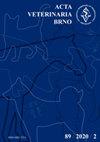年龄和干扰对饲养设施饲养的野鸡恐惧的影响
IF 0.7
4区 农林科学
Q3 VETERINARY SCIENCES
引用次数: 1
摘要
圈养野鸡在野外的生存主要取决于它们躲避捕食者的能力,因此,野鸡需要保持它们天生的反捕食行为。本研究的目的是评估年龄和干扰对商业饲养设施饲养的野鸡(Phasianus colchicus)强直不动(TI)的影响。分别对8、10、12、14和16周龄的野鸡进行TI检测。随机选择相同年龄的野鸡,在捕获后立即进行测试(C组),或在暴露于各种刺激/干扰后进行测试(D组)。在观察的野鸡组之间,诱导TI的尝试次数没有显著差异(绝大多数野鸡在第一次尝试时保持不动)。年龄的影响仅在D组中发现,14周和16周的鸟与年轻的鸟相比,TI持续时间缩短。C组不同年龄鸡的TI持续时间无差异。结果证明,根据圈养饲养的野鸡的年龄,对强烈刺激的反应中TI持续时间的变化。在确定野鸡放生的最佳年龄时,考虑到放生后对其生存的影响,了解反捕食行为的变化取决于年龄和对环境和新刺激的习惯,这是至关重要的。在年龄较大时被释放的鸟类,因此习惯了圈养饲养期间的反复干扰,可能会损害防御行为。本文章由计算机程序翻译,如有差异,请以英文原文为准。
Effects of age and disturbance on fear in pheasants kept in a rearing facility
The survival of captive-reared pheasants in the wild depends primarily on their ability to avoid predators, therefore, pheasants need to maintain their innate anti-predatory behaviour. The aim of this study was to assess the effects of age and disturbance on tonic immobility (TI) in pheasants (Phasianus colchicus) kept in a commercial rearing facility. TI tests were performed in pheasants aged 8, 10, 12, 14 and 16 weeks. Randomly selected pheasants of the same age were tested either immediately after capture (group C) or after exposure to various stimuli/disturbance (group D). No significant differences in the number of attempts to induce TI were found between the observed groups of pheasants (the vast majority of pheasants remained immobile on the first attempt). The effect of age was found only in group D, where birds aged 14 and 16 weeks showed a reduction in the duration of TI compared to younger birds. In group C, the duration of TI in pheasants of different ages did not differ. The results document a change in the duration of TI in response to an intense stimulus depending on the age of captive-reared pheasants. Knowledge of changes in anti-predatory behaviour depending on age and habituation to the environment and new stimuli is essential when determining the optimal age for pheasants to be released into the wild considering its impact on the subsequent survival of the released birds. Birds released at an older age and thus accustomed to repeated disturbances during captive rearing may have impaired defence behaviour.
求助全文
通过发布文献求助,成功后即可免费获取论文全文。
去求助
来源期刊

Acta Veterinaria Brno
农林科学-兽医学
CiteScore
1.00
自引率
33.30%
发文量
36
审稿时长
18-36 weeks
期刊介绍:
ACTA VETERINARIA BRNO is a scientific journal of the University of Veterinary and Pharmaceutical Sciences in Brno, Czech Republic.
The scientific journal Acta Veterinaria Brno is dedicated to the publication of original research findings and clinical observations in veterinary and biomedical sciences. Original scientific research articles reporting new and substantial contribution to veterinary science and original methods that have not been submitted for publication elsewhere are considered for publication. A written statement to this effect should accompany the manuscript, along with approval for publication by the author´s head of department. The authors bear full responsibility for the contents of their contribution. Book reviews are published, too.
 求助内容:
求助内容: 应助结果提醒方式:
应助结果提醒方式:


